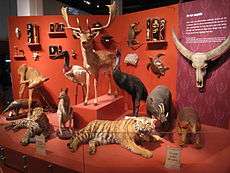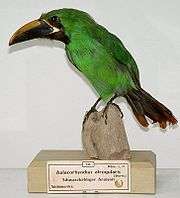Zoological specimen

A zoological specimen is an animal or part of an animal preserved for scientific use. Various uses are: to verify the identity of a (species), to allow study, increase public knowledge of zoology. Zoological specimens are extremely diverse. Examples are bird and mammal study skins, mounted specimens, skeletal material, casts, pinned insects, dried material, animals preserved in spirit and microscope slides. Natural history museums are repositories of zoological specimens
Study skins

Birds and mammal specimens are conserved as dry study skins. The skin is removed from the specimen, treated with absorbents and filled with cotton or polyester batting (in the past plant fibres or sawdust). Projecting thin wooden supports inside the bird specimens allow handling.Preparators use owire to support the legs and tail of mammals.Labels are attached to a leg of the specimen with thread. Study skins may be dried with heat or chemicals.



Skeletal Preparations (Osteology)
Osteological collections consist of cleaned, complete and partial skeletons, crania of Vertebrates, mainly birds and mammals. They are used in studies of comparative anatomy and to identify bones from archaeological sites. Human bones are used in medical and forensic studies.
Molluscs
In museum collections it is common for the dry material to greatly exceed the amount of material that is preserved in alcohol.The shells minus their soft parts are kept in card trays within drawers or in glass tubes, often as lots (a lot is a collection of a single species taken from a single locality on a single occasion). Shell collections sometimes suffer from Byne's disease which also affects birds eggs.The study of dry mollusc shells is called conchology as distinct from malacology (wet specimens).

Insects and similar invertebrates
- Main articles: Insect collecting
Most hard-bodied insect specimens and some other hard-bodied invertebrates such as certain Arachnida, are preserved as pinned specimens. Either while still fresh, or after rehydrating them if necessary because they had dried out, specimens are transfixed by special stainless steel entomological pins. As the insect dries the internal tissues solidify and, possibly aided to some extent by the integument, they grip the pin and secure the specimen in place on the pin. Very small, delicate specimens may instead be secured by fine steel points driven into slips of card, or glued to card points or similar attachments that in turn are pinned in the same way as entire mounted insects. The pins offer a means of handling the specimens without damage, and they also bear labels for descriptive and reference data.
Once dried, the specimens may be kept in conveniently sized open trays. The bottoms of the trays are lined with a material suited to receiving and holding entomological pins securely and conveniently. Cork and foam plastics are convenient examples. However, open trays are very vulnerable to attack by museum beetle and similar pests, so such open trays are stored in turn inside glass-topped, insect-proof drawers, commonly protected by suitable pesticides or repellents or barriers. Alternatively, some museums store the pinned specimens directly in larger trays or drawers that are glass-topped and stored in cabinets.
In contrast to such dried specimens, soft-bodied specimens most commonly are kept in "wet collections", meaning that they are stored in alcohol or similar preservative or fixative liquids, according to the intended function.
Small specimens, whether hard or soft bodied, and whether entire, dissected, or sectioned, may be stored as microscope slide preparations.
Wet specimens
"Wet" specimen collections are stored in different solutions. A very old method is to store the specimen in 70% ethanol with various additives after fixing with formalin[1] or in these days sometimes with a salt-solution.[2] Some methods are very useful, because the color can be preserved. (Salt-)Solutions like this are Jores,[3] Kaiserling[4] and Romhányi.[5] Modern specimens are stored in borosilicate glass due to its chemical and thermal resistance and good optical clarity.

Data
Minimum data associated with zoological specimens is the place and date of collection, attached to the specimen by a label. Additional information is the name of the collector and the habitat. Tissue from specimens may be saved for genetic studies (molecular data, DNA). Depending on the animal group, other data may be included, for instance in bird collections the bird’s breeding condition, weight, colours of its eyes, bills and legs and nature of the stomach contents.
Composite specimens
A single specimen may be a composite of preparations sharing a unique number. An example would be a vertebrate with an alcohol-preserved skin and viscera, a cleared and stained head, the post-cranial dried skeleton, histological, glass slides of various organs, and frozen tissue samples. This specimen could also be a voucher for a publication, or photographs and audiotape.
Voucher specimens
A voucher is a representative specimen of the animal used in a study, such as a specimen collected as part of an ecological survey or a specimen which was the source of DNA for a molecular study.Voucher specimens confirm the identity of the species referred to in the study. They are a backup against misidentification, changing species concepts which mislead results. Type specimens are a special type of voucher specimen used in taxonomy.

Historic specimens
Museum zoological specimens may have historic significance for instance the specimens collected by Johann Baptist von Spix and Carl Friedrich Philipp von Martius during their Brazil Expedition (1817–1820) are in Munich Zoology Museum.
Models
Museums make extensive use of models.When these are accurate they are considered to be specimens in their own right. Examples are the glass coelenterates of Leopold and Rudolf Blaschka
Examples
- Mount of African elephant in Paris Museum
 Chitra indica (narrow-headed soft-shelled turtle) skeleton
Chitra indica (narrow-headed soft-shelled turtle) skeleton Pinned insects (Dynastinae)
Pinned insects (Dynastinae).jpg) Microscope slides
Microscope slides Cast of a bird fossil
Cast of a bird fossil%2C_measuring_a_turtle_shell.jpg) Zoologist measuring a turtle shell
Zoologist measuring a turtle shell Acanthopterygii (fish) at Naturmuseum Senckenberg
Acanthopterygii (fish) at Naturmuseum Senckenberg- Model of Arenicola marina in a zoological exhibition at National Museum (Prague)
 Specimen of fish clarified for visualization of anatomical structures on display at the MAV/USP.
Specimen of fish clarified for visualization of anatomical structures on display at the MAV/USP.
See also
Further reading
- Hall, E. R. 1962. Collecting and preparing study specimens of vertebrates. University of Kansas Museum of Natural History Miscellaneous Publications no. 30. 46 pp.
- Hangay, G., and M. Dingley. 1985. Biological museum methods. Volume I. Vertebrates. Academic Press, Sydney, Australia
- Howie, F. M. P. 1985. Conserving Natural History Collections: Some Present Problems and Strategies for the Future. Proceedings of the 1985 Workshop on Care and Maintenance of Natural History Collections:1-6.
- Kageyama, M., R. Monk, R. Bradley, G. Edson, and R. Baker. 2006. The changing significance and definition of the biological voucher. In S. Williams and C. Hawks (eds.) Museum Studies: Perspectives and Innovations. Society for the Preservation of Natural History Collections, Washington, D.C., 259-266.
- McAlpine, Donald F. 1985. Curators and Natural History Collections: Have We Become Islands in Science?. Proceedings of the 1985 Workshop on Care and Maintenance of Natural History Collections:7-14.
- Suarez, Andrew V. and Neil D. Tsutsui. 2004. The Value of Museum Collections for Research and Society. BioScience 54(1):66-74.
References
- ↑ BLUM, J.: Formol als Conservierungsflüssigkeit. Zool. Anz. 16, 1893, Page 450-452
- ↑ COLEMAN, R. / KOGAN, I.: An improved low-formaldehyde embalming fluid to preserve cadavers for anatomy teaching. J. Anat. 192, 1998, Page 443-446
- ↑ JORES, L.: Die Conservierung anatomischer Präparate in Blutfarbe mittels Formalin. Zbl. Path. Jena 7, 1896, Page 134
- ↑ KAISERLING, C.: Über die Conservierung von Sammlungspräparaten mit der Erhaltung der natürlichen Farben. Klin. Wschr. 33, 1896, Page 725
- ↑ ROMÁNHYI, G.: Einfaches Verfahren zur Konservierung in natürlichen Farben. Virchows Arch. 328, 1956
External links
| Wikimedia Commons has media related to Zoological specimens. |
- Naturkundemuseum Stuttgart
- Zoological Collection Database SZN Impressive. Images of wet specimens,labels,catalogues etc.
- Biological Survey of Canada The role of voucher specimens in validating faunistic and ecological research
- Museum handbook
- UBC Bird skin preparation
- Texas Tech University Halter, A.S. Standards for management of the recent mammal and bird collections Texas Tech University
- Natural history collections of the University of Edinburgh
- Wet Specimen collection of the National Museum of Australia